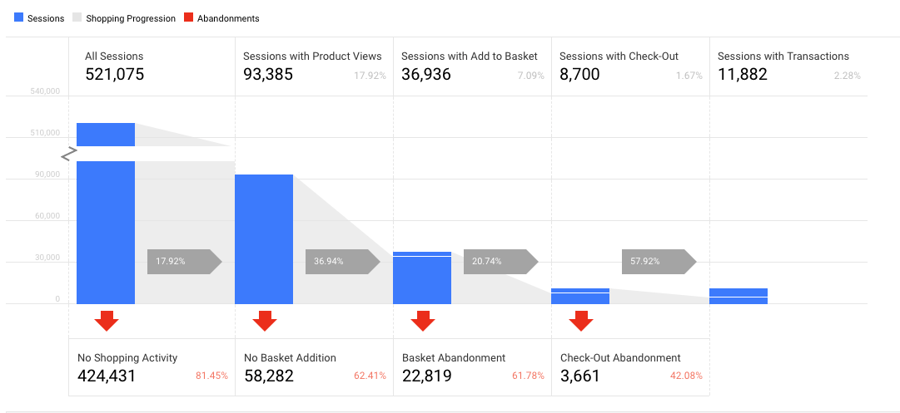
Cart abandonment online is a serious problem for retailers and online store owners. Not only do people abandoning their carts leave you, as the store owner, feeling seriously frustrated, but they dramatically reduce the amount of revenue your business brings in. In fact, most conservative estimates reveal that more than 70% of all sales are lost online because of cart abandonment. Some estimates on the higher end believe the actual number of sales lost because of shopping cart abandonment is closer to 83%.
That’s no small number.
And, if you were able to reclaim that 70% of sales (and profits), that number feels even bigger.
Of course, if it were easy to stop people from abandoning their digital shopping carts, every store owner would be doing it.
But, even though it’s not always a simple one-fix solution, there are several effective ways to help your digital store keep its sales by taking customers from shopping, to check out, and order placed. And no matter how frustrating cart abandonment is, it’s always good to remember that every store, no matter how big and popular, is struggling with getting people to finish checking out.
Worse than window shoppers in physical retail stores, online shoppers are able to simultaneously browse several different shops and items, quickly comparing everything (down to shipping costs and customer reviews) in order to make their final decision. And to make matters worse, online shoppers can “shop” with no real effort or intent of buying — it’s just a fun way to pass time for many consumers.
With that said, 2020 saw digital cart abandonment reach record numbers. As more people became unsure of the world (and their world), shopping habits changed, and fewer people actually spent money — especially on items now deemed “unnecessary” or “frivolous.” Because more people felt financially insecure during 2020, fewer people followed through with their shopping carts, abandoning them so that they could keep their money in case they need it. So while more consumers left their carts before checking out online, even more avoided putting any items in digital shopping carts altogether.
No wonder more online retailers became interested in abandoned cart recovery.
What is Cart Abandonment and How Do You Know it’s Happening?
Whenever someone visits your website and then leaves a page before completing the desired action, it’s considered “abandonment.” That means that there’s an “abandonment” rate on every page of your website that features a call-to-action (CTA).
Shopping cart abandonment, sometimes also referred to as “basket abandonment,” is a form of abandonment that happens when items are added to a digital shopping cart without ever being purchased. Shopping cart abandonment can happen at any point after an item has been added and for a variety of reasons, including the customer changing their mind or the customer getting frustrated and then leaving. Maybe the shipping costs were too high, the delivery time was too long, or the checkout process was too time-consuming.
In order to determine the shopping cart abandonment rate on your website or online store, you’ll need to divide the total number of initiated transactions (orders completed) by the number of abandoned shopping carts. Depending on where you get your analytics for your site, you’ll find these numbers in different places. If you don’t know where to find your shop’s analytics, it’s a good idea to create a Google Analytics account so that you can better keep track of how your website is performing. Most experts recommend looking at your cart abandonment rate at least twice a month to stay on top of any serious problems and course-correct as needed.
 Source: SaleCycle
Source: SaleCycle
There are a lot of reasons why potential customers abandon their shopping carts online, some of which are completely out of your control. However, by adopting cart abandonment solutions and maximizing your connection with your audience, you can reduce the rate of shopping cart abandonment and see your online store’s profits skyrocket.
Remember: The key to fixing digital shopping cart abandonment is making sure that it doesn’t happen in the first place. If it does, the only thing you can do is try to bring your lost customers back later.
In order to resolve most of the reasons for cart abandonment, it’s critical that you get into the mindset of your customer. By putting yourself in their shoes, you can better understand what their experience is like in your online store — and what exactly is causing them to leave before they click “Confirm Order.”
For a lot of online shoppers, authenticity and trust are of paramount importance. Why? Because the majority of online shoppers have never actually held your product themselves. Or, if it’s a digital product, they haven’t personally experienced it, making it more important that they trust you, the store owner or seller, to give them a good, authentic product. The more your online store and checkout process can include social proof, like testimonials from real customers, the more rapport you’ll create with your customers — and the more sales you’ll make every time they get ready to check out.
Once your potential customer makes it to the checkout process, the stakes become even higher, which makes the tweaks to your website and the overall experience even more important. If your checkout process is confusing, or if the overall look and feel of the checkout pages are different than the rest of your website, you can quickly lose your target customer’s trust. And, of course, if the checkout process becomes too lengthy, you’ll lose your customer’s attention, causing them to abandon their cart and forcing you to play defense with abandoned cart recovery.
What Are the Most Common Online Cart Abandonment Reasons?
While most online store owners will never know for sure why customers abandon their carts, there is a lot of research and analytics (including tried-and-true customer surveys) that reveal the most common causes. Below you’ll find the top seven reasons for digital cart abandonment, as well as the most effective cart abandonment solutions so that you can make more sales.
1. Unexpected shipping costs

When your customer finally makes it to checkout, one of the biggest reasons they’ll end up abandoning their cart is because the shipping costs make their total cost too high. According to a survey of international online shoppers conducted at the beginning of 2019, 41% of shoppers had ditched their shopping cart online when they saw the final cost of delivery was much higher than they were anticipating. Because nearly half of all online shoppers said unexpected shipping costs were why they abandoned their shopping carts, this reason is the #1 reason why shopping carts get abandoned.
And it makes sense.
When a customer sees the price of a product, they typically assume there will be shipping charges included. But when the price of shipping increases the total checkout cost too dramatically, the customer can no longer justify following through with their purchase.
The easiest way to solve this problem is to make sure shipping costs are clearly marked online. When possible, use “Free Shipping” offers to help allay the fears of potential customers. And, remember, you can always increase your product price in order to absorb the cost of shipping so that your shipping costs can be low enough that they don’t scare away shoppers.
2. Price comparison
Another one of the major reasons for cart abandonment online is because digital shoppers found a better price somewhere else. According to studies, nearly 34% of online shoppers never finish checkout because they found a better price somewhere else. Some of these price-comparison shoppers also never checkout anywhere online simply because the cost of the item they want is too high across the board.
When your store loses a sale to price comparison or the competition, one of the best things (and only things) you can do is stay in touch. While you might not have been able to give them the offer they were looking for, an upcoming sale or a new product might interest them at a later date. This strategy is known as a “recovery campaign” because it can recover the sale in the future, especially if you offer an irresistible discount that makes your store and product too appealing to ignore.
3. Decided against the purchase
When a customer isn’t ready to buy a product, there isn’t too much you can do. After all, it’s up to them to eventually pull the digital trigger in the end. Just like physical store owners have to deal with window shoppers, digital store owners see the same customers when they look at bounce and abandonment rates. According to several surveys of online shoppers, close to 15% of them actually abandon online carts so that they can go to a physical store, presumably so they can examine a product better or get a product sooner.
Again, there’s no definite way of knowing why a customer decides against a purchase. However, you can always improve your offer and online checkout experience in order to decrease the number of customers who abandon their carts. And, thanks to email campaigns and social media, you can stay in touch with customers who decided against checking out so that you’re top of mind whenever they are ready to make a purchase. In this way, you can ensure that your abandoned cart recovery program is optimized and earning you more revenue.
4. Product was out of stock

One of the most frustrating reasons for cart abandonment online is because digital consumers discover that the product they wanted is now currently out of stock. Not only is this a horrible customer experience because of the time they wasted, but it also reflects poorly on the systems your business has in place. When a potential customer wastes their time trying to check out, only to discover that the product is unavailable, it is very unlikely that they will come back to your store — especially if it’s their first time there.
Thankfully, one of the easiest fixes for this is to upgrade your digital shopping cart service so that includes inventory tracking. Great shopping carts will also gather customer information when a product is out of stock (well before they get to the checkout process) so that they can be informed as soon as the product is back in stock.
The more consistent you can be with keeping your products well stock, and knowing the rate at which you need to re-stock, the more you’ll be able to reduce shopping cart abandonment in your online store. Also, remember that your online shop should clearly label products that are out of stock so that potential customers never waste their time and associate your brand with a poor shopping experience.
5. Delivery time was too long
According to data, more than 1/4 of all online consumers abandon their shopping carts because they won’t be able to get their product fast enough. While some products are expected to ship slowly, like those that are handmade or getting shipped from a small country, most people shopping online today are accustomed to relatively fast shipping and delivery times. If your store doesn’t deliver on these expectations, then it’s likely that they’ll leave their cart and go somewhere else.
If you want to reduce the rate of shopping cart abandonment on your site, then you’ll need to make sure you’re competing in terms of delivery time and shipping reliability. By offering flexible shipping options at a premium price, including rushed and expedited shipping, you can meet customers’ expectations and give them the experience they’re looking for.
6. Didn’t offer the preferred method of payment
Nearly 7% of online shoppers will abandon their shopping cart when they’re checking out because of the payment processor being used. Another 4% will leave during the checkout process because a credit card gets declined or there’s only one way to pay instead of several options. In fact, a surprising 59% of online shoppers said that they will leave their shopping carts during the transaction if they’re not able to use the payment method they want.
Whether it’s because they only trust certain processors or because they don’t want to manually enter their information when other processors do it for them automatically, this step of the checkout process is critical. As a store owner, you want to make sure you’re using the popular and trusted payment processors, as well as displaying “trust” and “secure” badges on checkout pages. While they might seem unessential, these small seals and badges actually are proven to boost sales by a whopping 28.2%.
The takeaway here is to make sure that your online store gives your customers several different ways to pay. The more flexible you can be (think payment plans and access to digital wallets), the smoother the experience will be for your customers and the less likely they will leave during checkout.
7. Complicated checkout process
When checking out becomes a chore, customers are going to abandon their carts — especially when they’re using a mobile device or are away from their home or office. According to the Baymard Institute, 24% of online shoppers leave their shopping carts when they are required to create a user account. Additionally, another 18% of customers said that they won’t finish checking out online if the process takes too long or becomes complicated or confusing.
In order to cut down on this cart abandonment issue, you’ll want to make sure that your checkout process is as simple and fast as possible. While you can encourage guests on your website to create an account, there should always be an option for them to continue their order as a guest. A lot of times, these guest checkouts will create accounts after they finish checking out if you give them an opportunity.
Conclusion
Cart abandonment will always happen on your website no matter how streamlined your process is — or how great your products are. With that being said, there are plenty of ways to reduce cart abandonment so that you increase your revenue and earn more customers. As a quick overview, here are some of the best cart abandonment solutions for your online store:
- Give a variety of payment options for your customers during checkout
- Ensure that the online experience is as streamlined and simple as possible
- Earn trust by using badges and seals, as well as customer testimonials and reviews
- Allow customers to checkout as guests
- Clearly display all costs before checkout and reduce shipping costs and fees as much as possible
- Make sure your website loads quickly
- Optimize your delivery times in order to compete
- Offer express and expedited shipping and delivery at premium rates
- Let customers get in touch with you easily and quickly for the best experience possible
If there’s only one thing you do in order to reduce cart abandonment rates on your website, it should be improving your customer experience. The more they enjoy using your website because it’s simple and convenient, the more they’ll want to finish their shopping experience.





Leave a reply or comment below